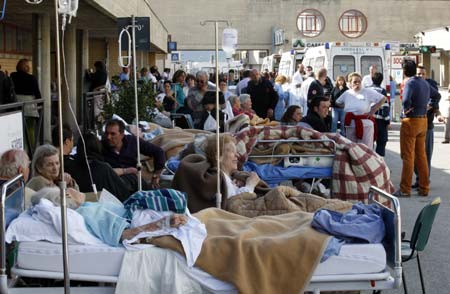"Already 150 people have been extracted and saved from the ruins," he added.
 |
|
People rest outdoors after an earthquake caused the collapse of St. Salvatore Hospital in Aquila April 6, 2009. A powerful earthquake struck a swathe of central Italy as residents slept on Monday morning, killing about 250 people and flattening whole towns.[Xinhua]
|
"In this hard moment we must all react with facts and actions. Rescue teams are saving everyone, no one will be left alone and this is the most important thing," he said.
At the press briefing, Berlusconi also said "there are no problems regarding financial aid. The government has already activated the natural calamities' fund to face housing reconstruction and survivors' needs.
"We must do all we can to guarantee a rapid help to those that are still under the ruins of the buildings. Rescue efforts are constant and must never cease, our men are using optic fiber video-cameras to search underground," he said.
Talking about the progress of rescue work, Berlusconi said "1,000 firemen and 4,000 rescuers are being employed" in the areas hit by the earthquake.
He also said "the first 'new town', envisaged in the national housing plan, will soon be constructed near L'Aquila" to host families that have lost their houses in the tremor. There will be a great contribution from the private building sector as well, he added.
Regarding entrepreneurs who have lost their job, the premier said the "government will include in the unemployment benefits' reform financial help for Abruzzo's businessmen whose economic activities have been destroyed."
The problem of listing damaged cultural monuments will be faced in a second moment. "People come first, this is our slogan," said Berlusconi. "Only then we will think of reconstructing Abruzzo's national heritage."
In the other developments, rescuers on Tuesday officially called a halt to the rescue operation in Onna, the small town nearL'Aquila which was worst hit in Monday's earthquake.
Forty people died from a population of 350 in the town, which is situated 10 kilometers from the Abruzzo capital of L'Aquila.
Firemen said they would now concentrate on removing rubble and securing buildings in the remains of Onna, where plaster continued to crumble as aftershocks continued on Tuesday.
Earlier in the day, the civil protection department said inspections of homes and public buildings damaged in Monday's earthquake will begin on Wednesday and residents will be allowed back to their homes if they are found to be safe. Natale Mazzei of the department's emergency office said over 200 teams of experts would be conducting the inspections.
Also on Tuesday, Vincenzo Ferrini, head of earth science at Rome's La Sapienza University, said Rome is largely protected from earthquakes with their epicenter in the neighboring region of Abruzzo thanks to its bedrock of sedimentary tuff rock.
"In and around Rome the ground is less favorable to the transfer of seismic waves because the area rests on volcanic tuff and not on calcareous rock," he said.
"We can be relatively unworried," he said. However, had the earthquake's epicenter been 50 km rather than 100 km from Rome, Ferrini said the damage to the capital would have been significantly greater, although "not completely destructive".
"Cupolas could have fallen and there could have been damage to the Colosseum," he said. Ferrini said that aftershocks from Monday's main quake 100 kilometers away in Abruzzo would likely continue to make themselves felt in Rome.
"For that reason we need to watch out for falling cornices and plaster, which has happened in rare cases in the last few hours," he said.
Several buildings in Rome were evacuated as a precaution on Tuesday after a strong aftershock registering 4.7 on the MMS scale was felt in the capital.
Monday's main earthquake, which registered 6.2 on the MMS scale, was clearly felt in Rome.
(Xinhua News Agency April 8, 2009)